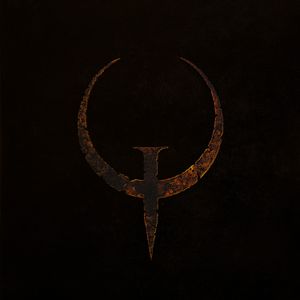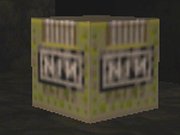Difference between revisions of "Quake Soundtrack"
| Line 3: | Line 3: | ||
'''Quake''' is a video game by id Software released on June 22, 1996, which features music composed by [[Trent Reznor]]. Most versions of the game included 10 audio tracks from the game as standard CD-Audio files, so the game disc could be played in a CD player with the first track reserved for game data (which cannot be read by a CD player), and 10 additional tracks of music. Some versions of the game include shortened edits of the music tracks. | '''Quake''' is a video game by id Software released on June 22, 1996, which features music composed by [[Trent Reznor]]. Most versions of the game included 10 audio tracks from the game as standard CD-Audio files, so the game disc could be played in a CD player with the first track reserved for game data (which cannot be read by a CD player), and 10 additional tracks of music. Some versions of the game include shortened edits of the music tracks. | ||
| − | Other members of [[Nine Inch Nails]] also helped to create the music.[https://www.quaddicted.com/interviews/americanmcgee] Reznor was also responsible for the game's sound effects. It is notable that this soundtrack contains [http://en.wikipedia.org/wiki/Ambient_music ambient music], which Reznor went on to explore further on | + | Other members of [[Nine Inch Nails]] also helped to create the music.[https://www.quaddicted.com/interviews/americanmcgee] Reznor was also responsible for the game's sound effects. It is notable that this soundtrack contains [http://en.wikipedia.org/wiki/Ambient_music ambient music], which Reznor went on to explore further on ''[[Ghosts I-IV]]'', ''[[The Social Network Soundtrack]]'', ''[[The Girl With The Dragon Tattoo Soundtrack]]'' and the ''[[Gone Girl Soundtrack]]''. |
| − | |||
| − | |||
==Track Listing== | ==Track Listing== | ||
| Line 178: | Line 176: | ||
*Written by Trent Reznor (C) 1996 Leaving Hope/TVT Music. ASCAP | *Written by Trent Reznor (C) 1996 Leaving Hope/TVT Music. ASCAP | ||
*Special thanks to Trent Reznor and Nine Inch Nails for sound effects and music. | *Special thanks to Trent Reznor and Nine Inch Nails for sound effects and music. | ||
| + | |||
| + | ==Trivia== | ||
| + | A particular weapon in game play is the "nailgun" which can be reloaded by collecting ammo boxes decorated with the NIN logo. Also, Reznor was the original choice for sound design on id Software's ''Doom 3'', but circumstances halted his involvement. Former NIN member [[Chris Vrenna]] composed the game's theme song. | ||
==External Links== | ==External Links== | ||
Revision as of 05:02, 7 October 2014
Quake is a video game by id Software released on June 22, 1996, which features music composed by Trent Reznor. Most versions of the game included 10 audio tracks from the game as standard CD-Audio files, so the game disc could be played in a CD player with the first track reserved for game data (which cannot be read by a CD player), and 10 additional tracks of music. Some versions of the game include shortened edits of the music tracks.
Other members of Nine Inch Nails also helped to create the music.[1] Reznor was also responsible for the game's sound effects. It is notable that this soundtrack contains ambient music, which Reznor went on to explore further on Ghosts I-IV, The Social Network Soundtrack, The Girl With The Dragon Tattoo Soundtrack and the Gone Girl Soundtrack.
Contents
Track Listing
- game data
- "Quake soundtrack - Track 1" - 5:05
- "Quake soundtrack - Track 2" - 2:23
- "Quake soundtrack - Track 3" - 8:18
- "Quake soundtrack - Track 4" - 6:02
- "Quake soundtrack - Track 5" - 7:20
- "Quake soundtrack - Track 6" - 8:35
- "Quake soundtrack - Track 7" - 5:33
- "Quake soundtrack - Track 8" - 6:26
- "Quake soundtrack - Track 9" - 3:30
- "Quake soundtrack - Track 10" - 5:13
Alternate Track Titles
There are in fact no official names for these tracks, as they remain untitled in the accompanying game literature.[2] They can be referred to by their track number; however, because the first audio track is the CD's second track (the first being reserved for the actual game data), this usually leads to confusion. As such, they can also be referred to in the format of Ghosts I-IV track titles (e.g. "02 Quake I"), numbers (e.g. "Quake 1"), sequenced untitled tracks, and so on.
Alternatively, fan-made titles and game level names are often brought up when CD ripping/playing software looks up the information on the CDDB:
- game data
- "Persia Inversion", "Quake Theme" or "Main Theme"
- "Aftermath", "The Life Beneath It All" or "Intermission"
- "The Hall of Souls", "Conscience" or "Start/Whispers"
- "It is Raped", "Freezing Vertigo" or "Grisly Grotto"
- "Parallel Dimensions", "The Journey" or "Slipgate Complex"
- "Life", "The Hammer" or "Underearth"
- "Damnation", "Ice" or "Castle of the Damned"
- "Focus", "Peace?" or "Necropolis"
- "Falling", "Violence Inside" or "Ziggurat Vertigo"
- "The Reaction", "Death" or "Gloom Keep"
In-game appearances
| Dimension of the Doomed
the mystical past comes alive... |
Slipgate Complex
(E1M1) Track 5 |
Castle of the Damned
(E1M2) Track 7 |
The Necropolis
(E1M3) Track 8 |
The Grisly Grotto
(E1M4) Track 4 |
Gloom Keep
(E1M5) Track 10 |
The Door to Chthon
(E1M6) Track 3 |
The House of Chthon
(E1M7) Track 6 |
Ziggurat Vertigo
(E1M8) Track 9 |
| The Realm of Black Magic
ancient castles and strange beasts ahead... |
The Installation
(E2M1) Track 5 |
Ogre Citadel
(E2M2) Track 7 |
Crypt of Decay
(E2M3) Track 8 |
The Ebon Fortress
(E2M4) Track 4 |
The Wizard's Manse
(E2M5) Track 10 |
The Dismal Oubliette
(E2M6) Track 3 |
The Underearth
(E2M7) Track 6 |
no level |
| The Netherworld
primal fear in a strange dimension... |
Termination Central
(E3M1) Track 5 |
The Vaults of Zin
(E3M2) Track 7 |
The Tomb of Terror
(E3M3) Track 8 |
Satan's Dark Delight
(E3M4) Track 7 |
The Wind Tunnels
(E3M5) Track 10 |
Chambers of Torment
(E3M6) Track 3 |
The Haunted Halls
(E3M7) Track 4 |
no level |
| The Elder World
your worst nightmares come true... |
The Sewage System
(E4M1) Track 5 |
The Tower of Despair
(E4M2) Track 7 |
The Elder God Shrine
(E4M3) Track 8 |
The Palace of Hate
(E4M4) Track 4 |
Hell's Atrium
(E4M5) Track 10 |
The Pain Maze
(E4M6) Track 3 |
Azure Agony
(E4M7) Track 6 |
The Nameless City
(E4M8) Track 9 |
| Deathmatch Arena
and special levels |
Place of Two Deaths
(DM1) Track 4 |
Claustrophobopolis
(DM2) Track 4 |
The Abandoned Base
(DM3) Track 5 |
The Bad Place
(DM4) Track 1 |
The Cistern
(DM5) Track 4 |
The Dark Zone
(DM6) Track 4 |
Introduction
(START) Track 3 |
Shub-Niggurath's Pit
(END) Track 3 |
Track 2 plays upon completion of each level when statistics are shown (time spent, secrets, kills)
Credits
- Titles of songs or themes (C) 1996 TVT/Interscope Records.
- Written by Trent Reznor (C) 1996 Leaving Hope/TVT Music. ASCAP
- Special thanks to Trent Reznor and Nine Inch Nails for sound effects and music.
Trivia
A particular weapon in game play is the "nailgun" which can be reloaded by collecting ammo boxes decorated with the NIN logo. Also, Reznor was the original choice for sound design on id Software's Doom 3, but circumstances halted his involvement. Former NIN member Chris Vrenna composed the game's theme song.

